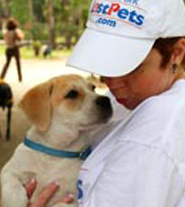Teaching A Dog To Come When Called
Here are some tips for helping a dog learn to come when called:
* Realize that your dog won't know what "Come" or any other command word means until you teach him.
* Whenever you see your dog coming toward you, say the word "Come." That will help him link the action with the word.
* Don't tell your dog to come unless you're in a position to enforce the command. Otherwise, the dog will learn that it is OK to ignore you...and will not learn what the word "Come" means. One approach is to start by having the dog on a long leash or line, which you can lightly tug to help remind him to come to you. (Note: when off-leash, make sure that you and the dog are in a fully fenced, secure area if not indoors.)
* Arrange things so that when you say "Come," there's a high likelihood that your dog will come to you. For example, say "Come" when your dog is looking at you and appears to be ready to return to you anyway. Or have really desirable treats to increase his motivation when you say Come. If your dog is motivated by play, hold his favorite play toy when you say come, and use a firm, positive, upbeat voice.
* If your dog previously learned to ignore the command-word Come, then use a fesh new word to represent the command, such as "Here!" or "Cookie!" or "Biscuit!" Then teach the dog that coming when called results in great things.
* When the dog comes when called, reward him, and also try not to end the fun at that time. Avoid having the dog associate the Come command with playtime ending, being pulled inside, etc. Keep it positive.
* Practice the Come command three times a day for at least two weeks.
Following is a detailed program for teaching a dog to Come when called, courtesy of trainer/author Sarah Wilson. This comes from Sarah's excellent e-newsletter, "Good Owners, Great Pets" (www.greatpets.com): * If you don't have verbal control, you must have physical control. Keep him on lead or in a fenced area. Sadly, every time he runs off, he is practicing running off and he gets better at it with practice.
* The next part of the plan is to really work on teaching him Come. Come is an easy command to NOT teach. Since the pup is underfoot in the house, we don't use "Come". The only time he hears it is when he is running around free having a blast and that is NOT the time to train.
First you have to teach it. Then you have to practice it. THEN you can start to use it. Here's an article I have on the subject that incorporates a nice method I learned from a "Good Owners, Great Pets" reader:
* For the next few days, anytime your dog is near you, tell him "Come" happily and give him a treat. Or Come and hand him a favorite toy.
Now, you think, "Hey, that is stupid! He didn't come!" Ah, but you are teaching him that when he hears the words come, something good happens right next to you.
* Once he is looking happy and wagging his tail when he hears "Come," start saying it when he is not looking at you or is a step or two away. Be sure to say it happily and try taking a couple of steps backward and praising him right after you say it. It would sound like "Jet, Come! Good BOY!!!"
* When Jet arrives, give him a treat or a toy or a romp. Basically, we want Jet to think that "Come" means "hustle over to my person because something delightful is about to happen."
* HINT: When you give him a treat for coming, hold your hand against your leg and make him reach in to take it. This will ensure that he comes all the way to you on "Come" and that he does not start standing 3 feet away and staring at you. That can happen if you hand him the treat instead of holding it next to your leg.
* Once he is responding eagerly to this, start adding in a "Sit" before you dole out the goodies. When that goes well, start working her on lead. As you're walking along, say "Come," then walk backward. As you walk backward, praise him merrily. As he approaches, slide your hand down the lead so that when he arrives, your hand is near his collar. Have him sit, then reward with praise, play, food and petting. Vary the rewards so he never knows what is going to happen; he just knows it will be something good.
* Once he is convinced that the command "Come" means good things, don't ever confuse him by saying "Come" then scolding him when he arrives. The rule is that he is ALWAYS safe and ALWAYS forgiven if he comes to you. Also, don't call him to do something he hates, like trim his nails or bathe him. Instead, in those situations, go get him. From now on, "Come" only means positive things.
Article courtesy of www.paw-rescue.org

Cofounder and Sponsor

Shelley Heistand
Premier Sotheby’s International Realty
407-718-9222
Cofounder Executive Director

Judy Charuhas
Contact Judy here

